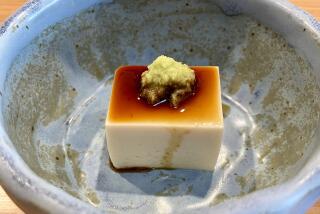Soy Talk With Father Tofu
- Share via
The frame around William Shurtleff’s computer monitor is a maze of adhesive memo notes. Only one, a giddy-looking character in color, catches the eye.
“That’s me,” says Shurtleff, tapping his finger on the fool, a figure from tarot cards. “He’s stepping off a cliff.”
Though Shurtleff is better grounded today, the man known as “the father of tofu” has long been off the edge. In 1975, he published what the world of soy regarded as its manifesto, “The Book of Tofu.” The white blob of soybean curd had found its cheerleader in a lanky, 34-year-old Stanford University engineering graduate. Twenty-one years later, Shurtleff is still tofu’s biggest booster.
As director of Soyfoods Center, the world’s only computerized database on soy and soy products, he has compiled more than 51,000 documents on soy, from 1100 BC to the present. It was started in 1976 by Shurtleff and artist Akiko Aoyagi, who would later become his wife.
The center occupies two rooms on the second floor of his modest home in an upper-middle-class neighborhood of Lafayette, 25 miles east of San Francisco.
Mention “The Book of Tofu” to aging baby boomers and it stirs up associations of meditation, the Esalen Institute, Frances Moore Lappe’s “Diet for a Small Planet,” whole grains and Tassajara--and not without reason. They’re all influences that shaped Shurtleff’s abstemious lifestyle.
In vintage bermudas and button-down shirt, he looks much younger than his age. The rubber thongs he prefers for comfort pose a momentary embarrassment when he goes to a nice restaurant. His angular face seems too small for his eyes, which pop like blue flash bulbs.
He has few diversions other than swimming. His television is used only for taping news programs. His preferred mode of transportation is a secondhand girl’s bicycle. He now uses the 17-year-old van in which he and his wife crisscrossed the country to speak on soy foods and world hunger to haul his son’s Little League team and make his biweekly trips to the science library at Berkeley.
Since his divorce three years ago, he runs the center alone except for a summer intern, usually a university student and always an Asian American. “I admire their work ethic,” he says.
His mission has changed little. He continues to promote soy as a key protein source.
The tofu book evolved from his seven years in Japan, where he went initially to study meditation, then later to research soy. He and Aoyagi tested 1,200 recipes over the years and pared them to less than 500. She illustrated the book and the cover. They produced 62 books (yes, 62). All, he says, are still in print.
The history of food, more than its pleasures, is what fascinates Shurtleff. He says he could be happy eating rice and vegetables for the rest of his life. It would be ridiculous to photograph him in a kitchen, he insists, when it is suggested. He’s a researcher, not a cook.
Few new soy products escape his attention. He tests them on his son and father. Veggie burgers are the current rave.
Tofu has progressed well, he says, ticking off statistics and names of companies like a Dow Jones ticker tape. “We’re on track. Maybe even ahead, if you compare soy to yogurt.
“When yogurt was introduced more than 40 years ago, Americans didn’t like it. They complained it tasted sour. So manufacturers added sugar and fruit and flavors, better packaging, more innovation. Look at it now. Kids eat it as a snack.”
He has whittled down his participation in soy activities. Before, he enjoyed the networking. Now, time is precious; money too. Though he cannot refuse a caller who wants advice on soy in the diet, he thinks he can help more people by publishing one book.
He believes the most significant event in the recent history of the soy movement happened Aug. 3, 1995, when the New England Journal of Medicine published an analysis of major research studies, linking consumption of soy protein to lowered blood cholesterol levels. The evidence suggested that replacing animal protein with soy protein could help prevent heart disease.
“For us in soy, it meant acknowledgment by the medical community,” Shurtleff says. But he acknowledges that tofu will never go completely mainstream: “It looks funny to Americans and it is difficult to overcome the image of the white blob.” Still, he thinks progress is being made.
As if to validate this, he suggests a quick visit to a bagel shop in Lafayette. A crowd is elbowing at the sales counter and bagels and cream cheese spreads are finding their way home in bags.
Shurtleff looks over the sea of heads and up at the menu. He points out one of the spreads, a tofu-based one.
“Just great, isn’t it?”
More to Read
Eat your way across L.A.
Get our weekly Tasting Notes newsletter for reviews, news and more.
You may occasionally receive promotional content from the Los Angeles Times.






